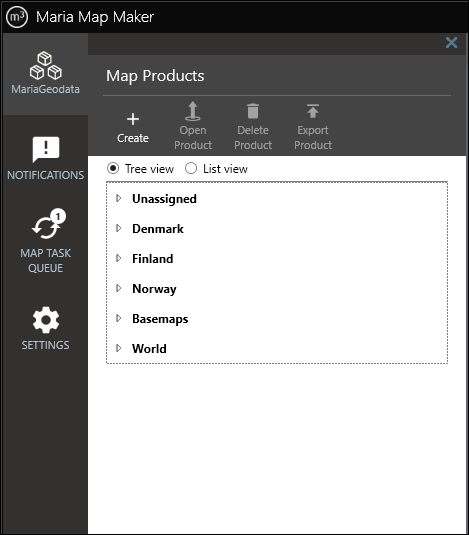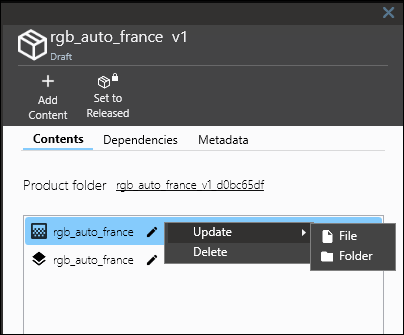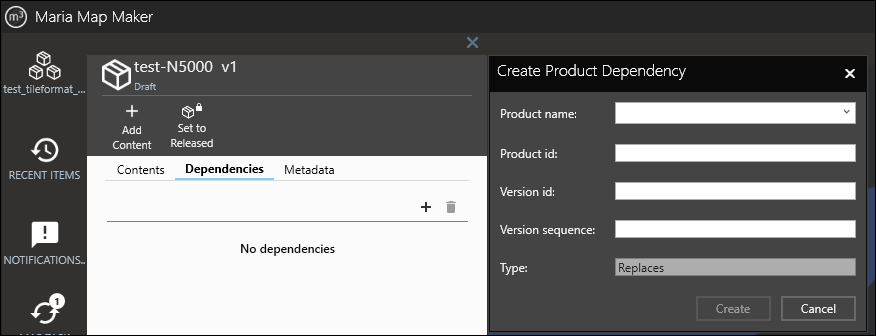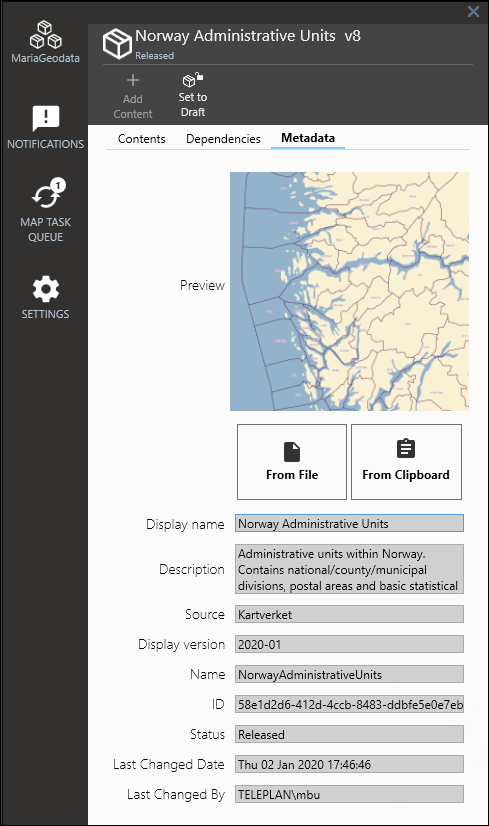Products
In M3, the product is a mandatory container for maps. It is a folder on the file system whose name consists of a user-defined name, sequence number, and a version ID. For example
WorldNauticalDNC_v1_d04495f7
Every product contains a metadata file with extension .productmetadata.xml. Among other information, it contains the Product ID, which uniquely identifies the product. It is a randomly generated string of characters (GUID). The Product ID will remain unchanged even as the product is updated.
Product organization
Open a workspace to view a list of products. There are two ways to display this list. The Tree view lets you organize your products in "virtual" folders. You can create folders with the Create button, or right-clicking on an empty spot below the tree. Sub-folders are created by right-clicking existing folders. They can then be filled with products by dragging and dropping (You can't change the folder of a released product, however).
Organizing the products in virtual folders does not actually move them around in the file system. The virtual path is just a string which is stored in the product metadata file.
Conversely, the List view ignores the virtual path and displays all products in a flat list.
You can create new products, and delete or open existing ones.
You can delete multiple products by selecting them using the Ctrl key, and clicking Delete Product. Note that if a product is open, you can't delete it.
You can create a copy of a product by right-clicking it, and then assigning a new name. A copy of the product will be created, where all its contents (overlays,basemaps, datasets) will keep their names, but recieve new unique id's.
Versioning
All products have three metadata elements which combined define the product version.
| Status | Either Draft or Released. |
| Version ID | A shortened GUID which is re-generated every time the product changes status to Draft. |
| Sequence number | Starts at 1 in new products, incremented by 1 every time a product changes status to Draft. |
Changing the status of a product is done by opening the product and clicking Set to Draft or Set to Released
Set to Draft
You will be prompted to choose wether to change the status on a copy of the product, or to change the status on the product directly. The sequence number will be incremented and a new version ID will be generated.
The product and its contents are unlocked for editing.
Set to Released
You will be prompted to choose wether you want to create an Accompanying letter, which will be stored as an HTML file in the released product. You can edit some aspects of the accompanying letter from the vertical toolbar, with SETTINGS → Product.
A file manifest ProductName_v1_290d104e.productmanifest.xml will also be generated, which allows the application using the product to verify that no files have been changed since release of the product.
The product and all its contents are locked from editing. The only allowed change is setting the status back to Draft (It's still possible to open basemaps and overlays to view the maps).
Contents
The contents of a product can be viewed by opening it (it's the default tab). Here, any basemaps, overlays and datasets will be shown. They can in turn be opened by double-clicking or left-clicking the "edit"-symbol.
You can create new content in the product with Add Content. Choosing Basemap or Overlay will create the file and automatically open it. Choosing Elevation lets you select a file or folder of elevation source data, which will be added to the product via a Map Import.
Updating datasets
From version 4.2
Datasets can be updated by right-click -> Update dataset. You can then select the source data with which to update - a single file or a folder. A Map import will start, where the destination options (Name, Workspace, Product) are already fixed and cannot be changed. The map import will replace the data file in the dataset, leaving everything else - name, map signature and metadata, as it were. This means that basemaps and overlays referencing the dataset will still work, and will now display the updated dataset.
Currently, updates are supported for all dataset types except for vector datasets.
Dependencies
The dependency is a concept which allows a product to remove other products when it is installed. The main usecase for this functionality is if you have two products covering two areas - for instance counties. If these counties should be merged, then in the next version you'll want to create a new product, and you also want to remove the two older products when it is installed.
Click the + to add a dependency to another product in your workspace.
From version 4.2:
You can also drag and drop products from Windows File Explorer onto the Dependencies window. You can drag-drop product folders, or a folder containing product folders.
Product metadata
Some metadata fields can be edited by the user if the product has status Draft. Others are automatically set when the product changes status. You can see the product metadata in the Metadata tab in an open product. In addition to text fields, you can upload a preview image to the product. The image is intended to be a small representative preview of the maps in the product. The image can be uploaded as a PNG file, from the clipboard, or directly from the map.
When you edit a field, the change is saved automatically.




